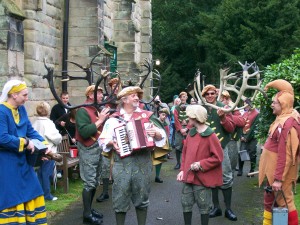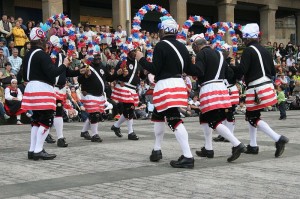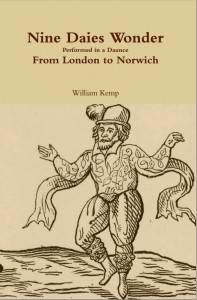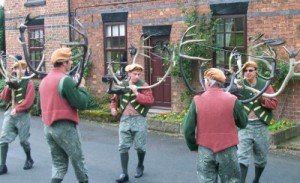Category Archives: Dances
The Britannia Coconut Dancers
From the town of Bacup with blackened faces and unusual costumes comes a unique folk dance troup. The team dances several garland dances once common as part of rushbearing festivals around the area, but also a “nut dance” of which they now seem to be the sole surviving example.
Whilst the clogs shirt and britches are traditional Lancashire, the white and red hooped skirt and white hat/turban seem more exotic in origin.
While Morris Dancing is rumoured to have been derived from the dances of the Moors, the African tribe that conquered large parts of Spain, Portugal and Southern France. The tradition danced by the Britannia dancers seems to have a more definite link. It is rumoured to have been taught to Cornish tin miners by Moors who came to this country and found employment in the mines. When the work in Cornwall became scarce during the 18th & 19th centuries some of the Cornish miners came to the North-West to work in the mines and quarries and brought the tradition with them.

Tunstead Mill Nutters 1907
Littleborough Rushbearing 2014
Abbots Bromley Horn Dance
On Wakes Monday (the first Monday between the 6th and 12th of September) the small village of Abbots Bromley in Staffordshire is host to a unique Horn Dance. (Details of the event can be found here)

The dancers start the procession at St. Nicholas Church.
The”horns” are six sets of antlers attacked to wooden skulls, three black and three white (although it is notable that Cecil Sharp referred to the black horns as being painted blue and an account from 1686 says they are red.) The horns themselves have been carbon dated to the early 11th century. These horns are on display in St Nicholas Church for the rest of the year, a replica set being used any other time the dance is performed.
The six “Deer-men” are accompanied by a musician playing an accordion, Maid Marian (played by a man), the hobby-horse, a jester or fool, a child with a bow and arrow and another with a triangle. Until the end of the 19th century the dancers were all members of the Bentley family, before the dance was passed to the related Fowell family.
Nine Daies Wonder – William Kemp
William Kemp was an English actor and dancer specialising in comic roles and is best known for having been one of the original players in early dramas by William Shakespeare.
Nothing is known of his origins but he is first noted as a performer with Leicester’s Men in May 1585. Kemp’s success by 1598 made him one of the core shareholders in the Lord Chamberlain’s Men (one of the leading theatrical companies of the time) alongside Shakespeare and Richard Burbage and was a sharer in the plans to construct the Globe Theatre.
In 1600 undertook his Nine Days Wonder a Morris Dance from London to Norwich an account of which he published as a pamphlet.
The last definite mention of him is in 1602, but due to a vague reference in parish records, he is thought to have died in Southwark in 1603, penniless.
The pamphlet was published with an introduction and notes by Rev. Alexander Dyce for the Camden Society in 1839 and has been reproduced by folkcustoms.co.uk (2012)
Morris Dancing
The Morris dance is common to all inhabited worlds in the multiverse.
It is danced under blue skies to celebrate the quickening of the soil and under bare stars because it’s springtime and with any luck the carbon dioxide will unfreeze again.
The imperative is felt by deep-sea beings who have never seen the sun and urban humans whose only connection with the cycles of nature is that their Volvo once ran over a sheep.
It is danced innocently by raggedy-bearded young mathematicians to an inexpert accordion rendering of “Mrs Widgery’s Lodger” and ruthlessly by such as the Ninja Morris Men of New Ankh, who can do strange and terrible things with a simple handkerchief and a bell.
Terry Pratchett – Reaper Man
Often seen as a quintessential English pastime, the full origins of Morris Dancing are lost in the mists of time. While there are mentions of sword dances, mumming plays, guising and other activities that we now associate with Morris, but it isn’t until the late 15th century that the term is first recorded. Even then, the term “Morys” seems to refer to a court dance rather than the public spectacle that it is today.
In 1492, the Spaniards having driven the Moors out of the country celebrated with a pageant known as a Moresca which included a sword dance. It is likely that this is where the association between the name and the form of dance originates. With sword dances widespread around the world, it is probable that Morris was either a renaming or an adaptation of a much older tradition, the sticks commonly used by Morris Dancers today a remnant of the original swords.











































